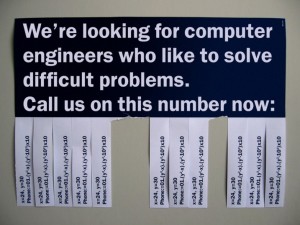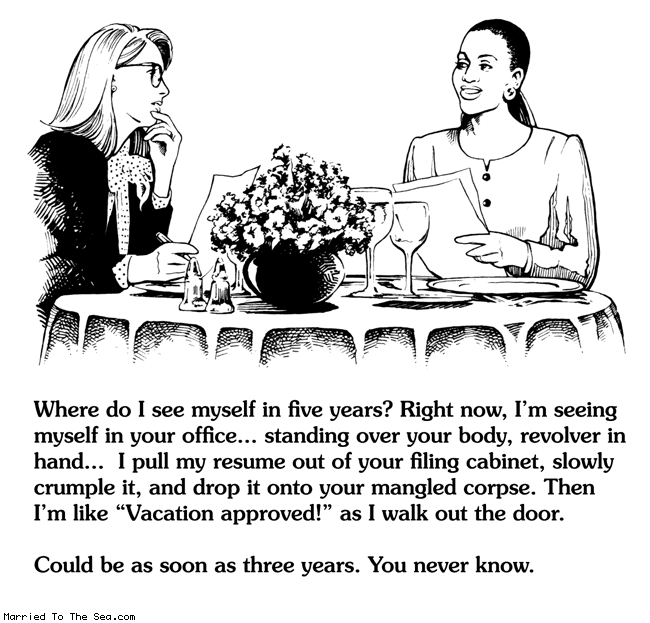Pre-Interview Preparation
As I promised in the last post , I’ll be covering hiring in greater detail over the next three installments. Today, I’m going to talk about what goes into effective hiring before the interview ever takes place. Future installments will cover the various interview styles you can choose from in some detail, to be followed by another installment on what sort of team involvement and interview format you choose.
The Ideal Candidate
Hiring, training, and acclimating a new person to your organization is estimated to cost anywhere from 17-32% of the position’s yearly salary. It’s for that reason alone, if not for the turmoil and disruption of bringing a new person into the team, that many organizations spend a lot of time trying to make hiring as bulletproof as possible. The last thing you want is for the new hire to not work out – it’ll cost a lot of money to fix the error!
The first element of your pre-interview preparation is to actually have a good idea what qualities and characteristics the ideal candidate should possess. A quality is an aspect of candidate’s personality that impacts their work behavior, such as punctuality, friendliness, or attentiveness. Characteristics are learned skills that help on the job, such as prioritizing well, communicating effectively, and meeting deadlines. This may sound like an elementary component of the process, but you’d be surprised how many times this essential and fundamental step is given short shrift.
TIP: A decent shortcut for this step is to consider someone in this job who’s already doing an excellent job. List out their qualities and characteristics while making the list as impersonal as possible.
PROS: By identify the qualities and characteristics of the ideal candidate, you can better control the composition of your team as a functional organism. Teams work best when their members enjoy each other and sync easily. If you work for a faith-based organization or non-profit NGO, you’re not likely to want a person on the team with an unrefined interest in altruism. If you work for a highly structured and conservative consulting company, you’re unlikely to opt for the Birkenstock and tie-die loving hipster. On the other hand, when you work on a team that gives a lot of product support, you probably want someone who’s warm and friendly to strangers. Now, remember that this does not mean your final candidate must have all or even most of these qualities and characteristics. This step is only performed to determine what qualities and characteristics will make the eventual candidate most successful in their job.
CONS: Failing to do a good job at this step is exponentially more likely to happen when you have an inexperienced, immature, or plain ol’ incompetent manager in charge of the hiring. I’ve worked in several organizations where the main reason the manager was seeking to hire a new employee was to simply increase the size of their team and, by extension, expand their own prestige. This behavior is sometimes called “empire building”. The most common result of this fault is a manager who hires people who are much like them without regard to whether they are competent or not. “He got the job because we’re both UT graduates!” is a common refrain in situations like this. This can deplete the team of diversity and a wide variety of experiences and preferences.
RESUMES
By focusing on the qualities and characteristics of the candidate, you can assess resumes with a new set of eyes. And this composes the second essential set in the pre-interview days of the hiring process – read all of the resumes. HR or your recruiter should be able to provide you with a big stack of resumes. But which ones are ideal? As the key technologist in the hiring process, you are uniquely able to identify those candidates who are ready for the next round in the hiring process. Furthermore, you should be able to identify the “diamonds in the rough” among your potential candidates. If you’re looking for a top-drawer .NET developer, you’ll be able to tell the ones who have four years of increasingly sophisticated experience from the ones who’ve had the same one year of experience four years in a row.
You’ve probably heard anecdotes about the amount of resumes floating around out there. One friend of mine at a major technology company said that he routinely sees eight hundred resumes submitted when he posts for an opening on his team. Of course, most of these resumes are weeded out by HR at his company. Needless to say, with eight hundred resumes to pick through shows that there’s no shortage of people apply for jobs. The shortage is usually for talented people.
When I have a large number of resumes to examine, I hate to say it but I usually look for any excuse to exclude a resume from further consideration. Spelling or grammar errors – you’re outta there! Formatting issues or inconsistencies – next! Employment dates don’t add up – gone! You can be much more forgiving, of course, when there are fewer candidates to assess. However, most people realize that their resume is their first foot in the door. If their resume isn’t showing a high degree of polish, what’s that say about other aspects of their professional demeanor and performance?
Ideally, though, when you evaluate a resume, you’ll easily be able to see whether the candidate meets the technical requirements of the job. If you’re looking for a developer, do they have the right sort of computer language skills? If you’re looking for an administrator, are they skill with the right operating systems and hardaware? While it takes some time, this is usually one of the easier steps of the process.
TIP: You should read all of the resumes as they’re presented by HR or your recruiter. You should also review the individual resume of each candidate about an hour before you interview them and identify any areas on the resume that you’d like to discuss in further detail. This step also ensures that the details about the candidate are fresh in your mind and avoids wasting time reviewing their resume while you’re sitting at the interview table with your candidate.
BEFORE THE INTERVIEW
Once you’ve pared down number of candidates to a short list, you can begin to schedule them to come in for the interviews. There are couple quick and easy things to remember at this stage:
- Make sure you have a quiet conference room available for the interview. If there’s not one in your office, consider going off-site to a quiet café or bistro.
- Make sure any other participants in the interview have read the candidate’s resume and are clear on their role in the process.
- Have printed copies of the resume available in case someone in a multi-person interview has forgotten their copy. Have an extra pen or two handy as well.
- Ensure that beverages, at least water and coffee, are available for a morning interview as a simple courtesy. Water and sodas in the afternoon are appropriate. If you have sodas, make sure at least one sugar-free option is available for diabetics and dieters. Why go to the trouble? Don’t forget that the candidate is also interviewing you to see if there’s a good fit.
- Unless the position you’re interviewing for is junior, interviews that happen around lunchtime should be followed up with an offer to pay for the candidate’s lunch.
- Bring your laptop to take notes. Most computer techies type much faster than they handwrite. You can also keep a list of your interview questions on the screen in such a way that it’s usually obscured from the candidate.
- After meeting the candidate but before the interview officially begins, conspicuously turn off your cell phone, put away your Bluetooth earpiece, etc. If the candidate doesn’t take the hint, ask them to do the same.
Following these steps sets the groundwork for a successful and effective interview. In the next installment of this series, we’ll discuss the various interview styles including sample questions, followed by another installment on what sort of team involvement and interview format you choose. Once you’ve gone through this process, you’ll find that hiring, like many things in the technology world, can follow a well-orchestrated template, making future efforts much easier.




Your comment regarding paying for the candidate’s lunch reminds me of something that you should NOT do: Schedule a lunch meeting upfront. One of the companies I was doing some work for sets up 4-5 hours of interviews and usually schedules a lunch in the middle at a nearby restaurant. Everyone — interviewers and interviewee — gets the schedule upfront. This has lead to some situations where the first three interviewers all say “no” — a sure sign the person has zero chance, and then someone has to go sit through a painfully drawn-out lunch for an hour. I guess it might have been nicer to just be upfront and let the person go on their way but most people don’t have what it takes to be that honest when the news is less than good…